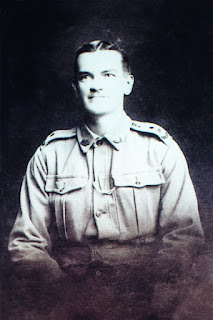Edgar John Appleyard
The seventh of ten
children, Edgar John Appleyard grew up in Alberton, a small town in South
Gippsland. His Grandfather Peter had
come to Australia as a convict and settled in Alberton 4 years after it was
surveyed. A pioneering family in the
district, Edgar’s father, Arthur Horatio was the Shire Engineer with his uncles
all playing a role in the opening up of the region to European settlers.
At the time World War
One began, Edgar was a labourer, 23 years old, single and presumably good on
horseback. Exactly what the Government was looking for as they sought Australian
men to fight for England. Just passing
the strict medical test, Edgar signed onto the 8th Light horse
Regiment in October 1914, three months after the war began.
Considered the ‘national
arm of Australia’s defence’, the Lighthorse Regiments were made up mainly of
young men from regional areas with many bringing their own horses. As part of their enlistment for the
regiments, the recruits would take part in a riding test which included riding
horses bareback over a variety of jumps.
On February 25, 1915,
Edgar left Melbourne on the Runic, arriving in Egypt on March 14.
Writing to his mother,
MaryAnn in April, Edgar said “Just sending you a few lines to let you know I am
still in the land of the living, right amongst the sand. It seems strange looking around. There are no signs of vegetation near the
camp. We are camped right close to the
pyramids. They are a wonderful piece of
work. One can hardly believe they were built 2000 years ago.”
In late May, Edgar, with
the rest of the Lighthorse regiment departed for Gallipoli. Leaving their
horses in Egypt, the regiment joined the Australian and New Zealand Division who
had suffered heavy casualties and formed the 3rd Brigade.
In August, the 3rd
Brigade would be almost decimated in the failed attack on Nek.
With nine tiers of
Turkish trenches full of riflemen and machine gunners waiting for the
Australians, the soldiers barely stood a chance as they made a dawn charge
across the narrow ridge.
Trained to fight in the
open with bayonets, the light horsemen charged towards the trenches in a hail
of bullets. Most men only ran a few
yards before they were killed. Three groups
from the regiment charged towards the Turkish soldiers and in 45 minutes, 234 light
horsemen would be killed and 138 wounded.
Surviving the battle, Edgar was sent to the site hospital twice during November, first with influenza and then for exhaustion before being sent to Heliopolis to rest, re-joining his unit in December as they returned to Egypt. It was at this time that Edgar was reported for being unshaven whilst on parade, receiving 2 extra stable piquets.
Avoiding the early
battles of the Sinai, the regiment was used to patrol the area for almost 12 months before the
British advanced into Palestine.
Edgar took part in the
Battle of Maghdaba in December 1916 and, after surviving the first Battle of
Gaza in March 1917, was injured on April 19 during the second battle, having
been shot in the back as he rode through the battlefield.
It took five days
for Edgar to arrive at the Military Hospital in Cairo and, by that time he was reported
as dangerously ill. Finally able to
receive proper medical care, x-rays would show that 3 of the vertebrae in the
thoracic region had been destroyed by the gunshot with the bullet exiting his
chest.
Due to his injuries,
Edgar remained on the dangerously ill list.
A letter to Edgar’s mother after he died reported that Edgar was never
considered likely to survive and it was only a matter of time but Edgar still
kept hope that he would return to the rolling green hills of South Gippsland.
Local papers reported
regularly on the war, particularly on soldiers from the region, and, through
his family, Gippslanders were kept up to date with reports of his condition included
in the Gippsland Times and Gippsland Standard newspapers.
In July 1917, 2 months
after he arrived at the hospital, Edgar wrote to his sister Harriet, beginning
with what had become his standard greeting.
“Just a few lines to let you know I’m still in the land of the living, although a bit of a wreck. Old Jacko fluked one into me at last and in rather a bad place in the back. I have lost the use of my legs and hips for the time being and it makes things fairly awkward.”
“Just a few lines to let you know I’m still in the land of the living, although a bit of a wreck. Old Jacko fluked one into me at last and in rather a bad place in the back. I have lost the use of my legs and hips for the time being and it makes things fairly awkward.”
“I am very comfortable
here now and get the very best attention.
Nothing seems a trouble to the sisters or orderlies day or night. My next move from here will be to Australia
with any luck.”
Sadly, within a month of
writing to his sister, Edgar would die as a result of his injuries with reports
showing he passed at midnight, August 2, 1917.
Buried on August 3, Trooper
Edgar John Appleyard’s final resting place would be Row F, Grave 283 in the
Cairo War Memorial Cemetery with the final words on his headstone to read,
“The
Lord gave, and he hath taken away.”
Edgar John Appleyard
Born 10 Dec, 1888 Alberton, Victoria, Australia
Died 02 August,1917
Cairo, Egypt
Relationship to Peter Appleyard: Grandson
Relationship to Peter Appleyard: Grandson
Image: Yarram and District Historical Society

.jpg)


Comments
Post a Comment